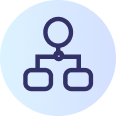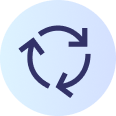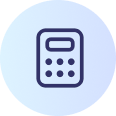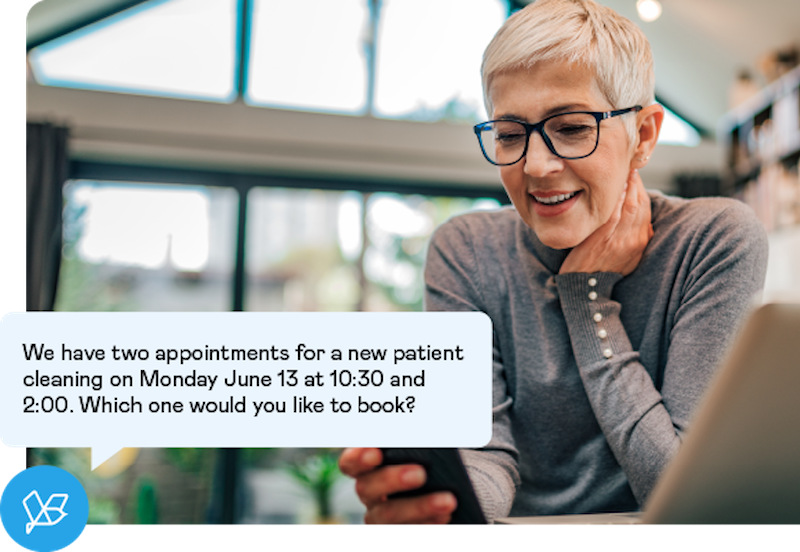Once out of reach, full-service AI is finally accessible to local businesses like dental practices. This is good news if you’re looking for a platform that actually drives the automation that you want from it.
What is a full-service AI patient communications platform?
Modern AI chatbots and patient communications software automatically take phone calls, converse with patients through voice, text and website chat, and enable them to complete transactions without needing intervention or help from a staff member.
Large enterprises typically have dedicated teams focused on AI transformation of their customer service model. However, this approach to AI enablement does not work for local businesses that often don’t even have an IT team in place, let alone AI expertise.
This is where a “full-service AI solution” changes the paradigm. Combining deep integrations with systems of record with white-glove implementation and performance management, these solutions are able to perform whatever function the patient is requesting with a very high degree of automation. Instead of passing a request to a staff member, a full-service platform takes the call, figures out what the patient needs and completes the transaction.
Software integrations include booking, payment, texting, and phone messaging systems. The combination of powerful software and backend practice management integrations empowers you to automatically:
- Convert phone calls and web visits to booked appointments
- Instantly engage new patients and automatically schedule their first appointment
- Allow patients to book, cancel and reschedule appointments
- Connect patients to your Point of Sale (POS) system to make payments
- Provide accurate and contextual answers to questions
- and… do all of these things anytime, day or night without a member of your staff needing to intervene!
What level of automation are we talking about?
Advanced tech and seamless integrations create a high level of automation that saves time and effort for your team. This ultimately reduces operating costs while helping you attract, serve and retain patients. Furthermore, a full-service platform tracks KPIs and always reports on the level of automation achieved. It also can automatically monitor performance and find ways to improve without needing any active management of the solution by the business.
Take the Call Handled rate, for instance. This metric shows the percentage of calls (or website visits) that are handled by the AI without a staff member stepping in. Remember, resolving an interaction means the software takes the call, assesses patient intent and brings it across the finish line by allowing the caller to execute on the task. An 80% Call Handled rate is not uncommon for our full-service patient communications platform.
Think about that for a minute. If you could automate 80% of patient calls, how would that streamline your operations? How many hours would that free up for your office staff?
Furthermore, if you are shopping for a platform, ask the vendor what Call Handled rate you can expect. If they can’t tell you, or if the platform doesn’t track it, we invite you to schedule a demo of our solution. During the demo, we’ll show you how our analytics dashboard tracks automation metrics in real time.
Why were full-service platforms previously unavailable to dental practices and DSOs?
It takes a lot of time, money and expertise to create an Artificial Intelligence-powered communications platform. Before cloud computing, if you wanted an AI communications solution, you would have to hire a company to create a custom system – and that’s too expensive for most dental practices. And even if you could afford custom software, you would still need an IT team as explained. A business with on-premise custom software has to implement it, train employees, update it when needed, troubleshoot when there are problems and provide HIPAA-compliant security. That’s a tall order for even large DSOs.
A cloud-based AI platform provider, on the other hand, has an army of technologists backing it up. Economies of scale allow dental practices to use sophisticated, customizable platforms for a few hundred dollars a month. Moreover, a good AI vendor ensures the practice extracts maximum value from the solution by providing ongoing support, customization and expertise.
How can a full-service system do so much?
Full-service solutions are trained on millions of dental patient conversations. For example, the TrueLark AI engine has handled six million calls (and counting). Because of this, it understands thousands of phrases and can parse nuances in language. In practice, this means it can discern intent and handle more complex interactions. For example, it can book appointments for multiple family members – a task impossible for an off-the-shelf chatbot.
A team of technologists at your service
An advanced Software as a Service (SaaS) platform is supported by specialists that not only get the implementation right, they continually identify gaps and fill them. When the platform can’t resolve an issue and it bubbles up to the staff, the support team can work with them to train the platform to recognize and solve the issue going forward.
Proactive, interactive and ongoing optimization ensure the platform continually delivers more business value to your practice.
The problems with off-the-shelf chatbots
Chatbots are also marketed to dental practices as a communications solution. Let’s discuss the differences between full-service AI and menu-based chatbot.
A chatbot can only handle simple requests
A chatbot typically doesn’t recognize anything other than simple keywords or key phrases and it also doesn’t integrate with practice management software. As a result, it’s unable to complete a majority of patient requests. It can’t transfer the patient to the booking system or the payment system, for instance.
Lack of integration severely limits what a chatbot can do. Let’s suppose, however, that you only want a texting chatbot to respond to calls after hours. Since it still can’t handle the patient’s issue, you’ve simply moved an unresolved problem from voice mail to a text exchange. While asynchronous communication has some value, it’s negated by the fact that many patients get frustrated when a chatbot can’t solve their problem and they still have to wait for a call back from a staff member.
As outlined above, this is what happens the majority of the time. It’s counterproductive to route patients through a chatbot only to need a staff member to take over. At that point, you’ve wasted the patient’s time and tested their patience. It also overburdens the employees because the chatbot poisons everything it touches, and they have to jump in and clean up the mess.
Perhaps you only want the chatbot to answer basic questions about your practice. Unfortunately, it’s not even equipped to do this. People rarely use pre-programmed keywords when asking questions. Therefore, a chatbot is ineffective for even the narrowest use cases. What’s worse, it creates a poor experience for both the patient and staff.
The false promise of chatbot automation
Let’s talk about chatbots from an automation perspective. Because of the problems previously explained, chatbots often can’t achieve even a minimal level of automation. In addition, they can’t improve over time either. There is simply no way an off-the-shelf chatbot can recognize where it’s failing and fix those gaps to enable increased automation. In other words, they start off weak and fail to get stronger.
Moreover, many dental practices that invest in a chatbot discover that it creates more problems than it solves – which is antithetical to the goal of process automation. At that point, the owner has wasted time and money. In short, chatbots are brittle, easily overwhelmed and provide little business value.
A full-service AI solution is more cost effective than a chatbot
An AI patient communication solution is more cost-effective than even the cheapest off-the-shelf chatbot. Because it can handle a wider range of interactions, it reduces the need for additional staff. It can also streamline your operations, leading to greater efficiency and higher profits. Because it provides a far better patient experience, a full-service platform can help retain patients. While a chatbot might be less expensive, in reality, it delivers far lower ROI.
Let TrueLark help
We are pioneers in Artificial Intelligence-powered patient communication. Our affordable solution manages and resolves thousands of conversations daily for dental practices across the country. It has an impressive breadth of function while being easy to use and quick to deploy.
We can help you better serve your patients, book more appointments, grow your revenue and increase efficiency. To learn how TrueLark can help your DSO or individual practice grow, schedule a demo today.
Originally published January 13, 2023, updated July 11, 2024.
Photo by Cedric Fauntleroy on Pexels.



















